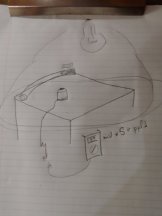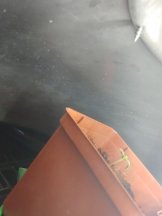Jewels
Bon~Fire
I am new here, just like looking to make a contribution. I figured the best way to get to know everyone is to start posting some provocative and controversial ideas.
I am trying to resurrect a sorry sprout. I need to give it the right amount of light. I am aiming for about 300 ppfd. How am I going to get it?
I am always stingy on the electricity so I choose from a selection of three bulbs.
Nobody knows. You just cannot just spot 300 ppfd with your eyeballs. You need a measurement.
Here is what you are looking at
The sensor sits on the milk crate. The clear tubing acts as a spacer. The rim of the reflector must remain touching the spacer, in any position, and the highest reading was taken.
This measurement shows the highest position of output for any given bulb. I took turns swapping out the bulb and manipulating the reflector around to achieve the highest reading from each bulb.
This is not a scientific test The twisty bulb is ancient, it may have a million or so hours on it.
The 13w LED threw the same intensity as the 44w cfluorescent twisty measured at the reflector lip distance. Quite a difference in light AND heat output.
The cob (?) 42w LED pushed almost identical ppfd as the other 2 bulbs!! All between 185 and 205.

I learned a few things. Firstly, this 14 inch reflector is vastly oversized for these bulbs. I infer this, because my highest measurements were all found directly under the bulbs. I also reinforced the certainty that none of these bulbs have any place in a flower or veg room.
So where is my 300 ppfd ?

,,,up under the reflector - four fingers away from a grocery store 13w bulb.
I am trying to resurrect a sorry sprout. I need to give it the right amount of light. I am aiming for about 300 ppfd. How am I going to get it?
I am always stingy on the electricity so I choose from a selection of three bulbs.
- ancient oversized twisty CFL, it is labeled at 44 Watts.
- conventional looking housedold globe shaped led , it is labeled at 13 Watts.
- The third bulb is a led twist-in. xx? ( I don't know what you guys call them) it is tagged at 42 Watts
Nobody knows. You just cannot just spot 300 ppfd with your eyeballs. You need a measurement.
Here is what you are looking at

The sensor sits on the milk crate. The clear tubing acts as a spacer. The rim of the reflector must remain touching the spacer, in any position, and the highest reading was taken.
This measurement shows the highest position of output for any given bulb. I took turns swapping out the bulb and manipulating the reflector around to achieve the highest reading from each bulb.
This is not a scientific test The twisty bulb is ancient, it may have a million or so hours on it.
The 13w LED threw the same intensity as the 44w cfluorescent twisty measured at the reflector lip distance. Quite a difference in light AND heat output.
The cob (?) 42w LED pushed almost identical ppfd as the other 2 bulbs!! All between 185 and 205.

I learned a few things. Firstly, this 14 inch reflector is vastly oversized for these bulbs. I infer this, because my highest measurements were all found directly under the bulbs. I also reinforced the certainty that none of these bulbs have any place in a flower or veg room.
So where is my 300 ppfd ?

,,,up under the reflector - four fingers away from a grocery store 13w bulb.
